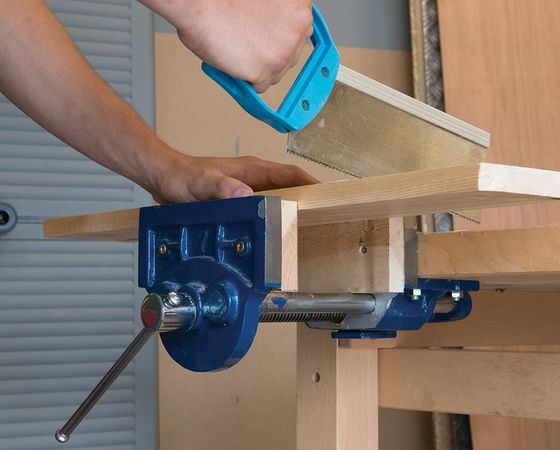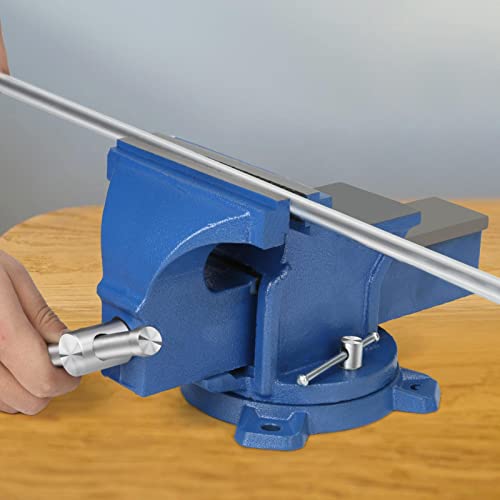Table of Contents
When you’re working on a project, it’s essential that you do so safely. If materials that you are working on are not secured, this poses a serious safety hazard as well as making life a lot more difficult. But that’s where a good bench vice becomes invaluable.
When you’re looking to buy a bench vice, it’s important to know exactly what you’re looking for. In this guide, we’ll be getting you better acquainted with this important bit of workshop equipment and helping you make a more informed choice on the right bench vice for your needs.
What Is A Bench Vice?
A bench vice is a piece of mechanical equipment that is designed to keep an object secure while it is being worked on. You will see bench vices in various situations as these are very commonly used tools for things like woodworking, metalwork, engineering and mechanics.
Where woodworking is concerned, this is a tool that you won’t be able to live without. It can benefit the user in several ways but one of the most effective is holding pieces of wood together after they are glued. Simply glueing stock and leaving it won’t create the bond needed for security but placing the pieces into a vice to provide added pressure during the drying process will give the bond optimal strength. Of course, sometimes, your vice may not be large enough, in which case, strategically placed weights will deliver the same results.
If you are working on a project that requires the removal of old nails from a piece of wood; perhaps for furniture restoration, then you’ll need something secure to keep the material still while you take out the nails. A bench vice is perfect for this and is much more reliable than even the most stable hand. Moreover, since the vice is doing all of the hard work for you, you won’t need to exert as much strength when pulling out old nails. This isn’t only easy, it is also far safer.
It goes without saying that, when working with wood and other materials, there will be a degree of cutting involved but this can be incredibly difficult when the material is moving around all over the place. Popping it into a bench vice will keep it still allowing you to perform a cleaner and safer cut with your saw.
These devices are also indispensable when it comes to drilling. Whether this is for carpentry or any other type of work, your vice will keep the material safely in place allowing you to drill through it much more easily. So you see, these are incredibly versatile pieces of equipment!
How Do Bench Vices Work?
The bench vice features two jaws, parallel to one another. These jaws can be opened and closed to allow for different sized objects and are tightened, securing the object in place.
Through the middle of the device, there is a threaded screw and this connects the two jaws to one another. The screw has a handle at one end allowing the user to turn this and this motion is what moves the jaws inwards and outwards. The jaws should move tightly enough onto the object to hold it in place but not so tight that the pressure causes damage to the piece being worked on.
How To Install A Bench Vice
It doesn’t take a genius to figure out that a bench vice, by its very name, is designed to sit on top of your workbench. But when you purchase your vice, you will need to first install it. This isn’t a difficult job but it’s essential to get it right.
Primarily, you need to decide on the best type of bench vice and where you are going to place it. This is so important because your decision will determine how easy the equipment is to work with. For example, you need to choose between an end vice or a face vice. It’s a good idea to have both but if your budget is tight then we would always recommend going for a face vice that sits at the front of the workbench.
You’ll probably need to choose a vice that is a little larger as this will help when performing tasks like planing edges of wood. A minimum of ten inches is best but then, it’s important to consider the type of work you will be doing and choose a size accordingly.
Before you do anything, you’ll also need to think about where on the front of the bench you are going to fit the vice. If you’re right-handed then it’s wise to place it to the far left whereas left-handers will be better off putting it to the far right. In any case, just be sure to choose a location where the bench legs won’t get in the way of the vice’s handle.
Fitting The Vice
Now you’ve made all of your important decisions, it’s time to install your vice. You’ll need to begin by marking out the mounting holes on your bench. You can do this by placing the vice into the desired positions and marking the area with a pencil. In some cases, your vice will come with a mounting template which makes life far easier but if you do decide to use this, just be sure that it matches the base perfectly. Sometimes, these templates can be off by quite a bit.
Next, you will need to choose an appropriate drill bit to drill out your mounting holes. When you start drilling, be careful not to put too much pressure on the bench as this may cause it to splinter as you break through to the underside. Once the holes are in place, use a washer to test the size and make any necessary adjustments.
Now take your vice and align it over your mounting holes, putting a washer and bolt into the holes. To the bottom of each hole, you’ll need to use a washer, a lock washer and a nut, tightening these initially by hand. Once you’ve done all the bolts, you can then use a socket wrench to fully tighten them, ensuring that the vice is firmly held in place. However, do be careful not to over tighten the bolts as this can put too much pressure on the wood of the bench.
Our Recommended Bench Vices
It takes nothing more than a quick look on the internet and in some of the best hardware stores in the country to see that there are a lot of choices when it comes to buying a vice. While there are many excellent products out there, we particularly like the following ones.
Clarke Bench Vice Workshop Swivel 6″
The Clarke bench vice is ideal for hobby woodworkers opening to a maximum width of 160mm which is suitable for a variety of applications. Moreover, this strong and sturdy vice allows for precise pressure when clamping, making working with your materials so much simpler.
It is a heavy and robust piece of equipment made from cast iron and once installed, won’t budge or weaken. This is an investment that will be with you for many years, if not forever!
We also love the swivel design of this vice, allowing you to turn it 360º to get it into just the right position no matter what you are working on.
- Proven reliable Clarke technology
- Lightweight construction at just 19 Kgs
- High performace for the home or tradesman
Best Budget Bench Vice – Trintion Table Vice 6″ Swivel Workshop Bench Vice
If you’re working to a strict budget, that doesn’t mean that you can’t pick up a reliable and secure vice that’ll serve you through many projects. It’s important to make sure that what you’re getting isn’t a cheap knock off but that certainly isn’t the case with the Trintion Table Vice which is designed for heavy-duty use and is made from solid cast iron, giving you the confidence that this is a robust bit of kit!
What’s more, it’s incredibly versatile and allows you to complete a number of tasks thanks to its rotating design. Moreover, the jaws are incredibly strong and stable, giving you just the right amount of force when clamped. Everything is super easy to use so this would make a good choice for something who is new to using this type of equipment.
- The heavy-duty bench vise is made of high-quality...
- The fixed vise base provides stability and is...
- The bench vise is easy to operate and provides you...
- The 6-inch vise is an essential tool in any...
- 6" bench vise has a lower jaw width of 150mm, jaw...
Conclusion
When you are sawing, gluing, drilling or doing anything else with wood and other materials, you need excellent stability if you want a safe and precise result. Trying to hold your materials by hand is difficult and won’t yield the best results so you need a good bench vice to make the job easier.






